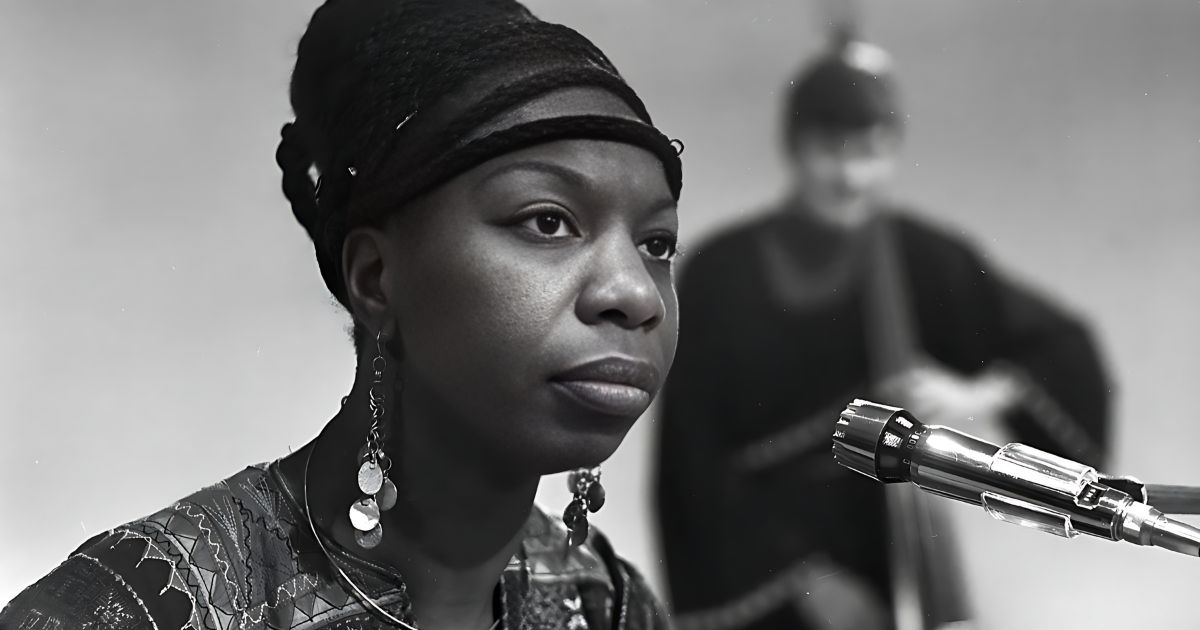Nina Simone’s Birthday
Nina Simone’s Birthday, February 21, 1933, marked the birth of the incomparable Nina Simone. On what would have been her 91st birthday, we reflect on the renowned singer, songwriter, arranger, pianist, and civil rights icon who left an indelible impact on music and culture.
Read More: Digital News Planet
Origins in North Carolina
Nina Simone’s story begins in Tryon, North Carolina where she was born Eunice Kathleen Waymon in 1933. The town was small, with a population of less than 2,000, but it fostered her prodigious musical abilities from early childhood.
Simone’s mother, Mary Kate Waymon, was a Methodist minister who sang gospel music and also worked as a housemaid. Her father, John Divine Waymon, was a handyman and entertainer who loved music. Both parents played a pivotal role in nurturing young Eunice’s talents. At the tender age of three, she climbed onto the piano stool at her local church and started playing, astounding the congregation with her natural gift. This occasion marked the beginning of a bright musical future.
By the time she reached six years old, Simone had taken over as pianist at her church. She was soon accompanying choir performances and Sunday services, gaining invaluable experience that informed her unique style of blending gospel, jazz, and classical music. When a local fund was set up to pay for piano lessons, eight-year-old Simone benefited, being sent to study with Muriel Mazzanovich, an English piano teacher who appreciated the young black girl’s abilities and took her on as a student for free.
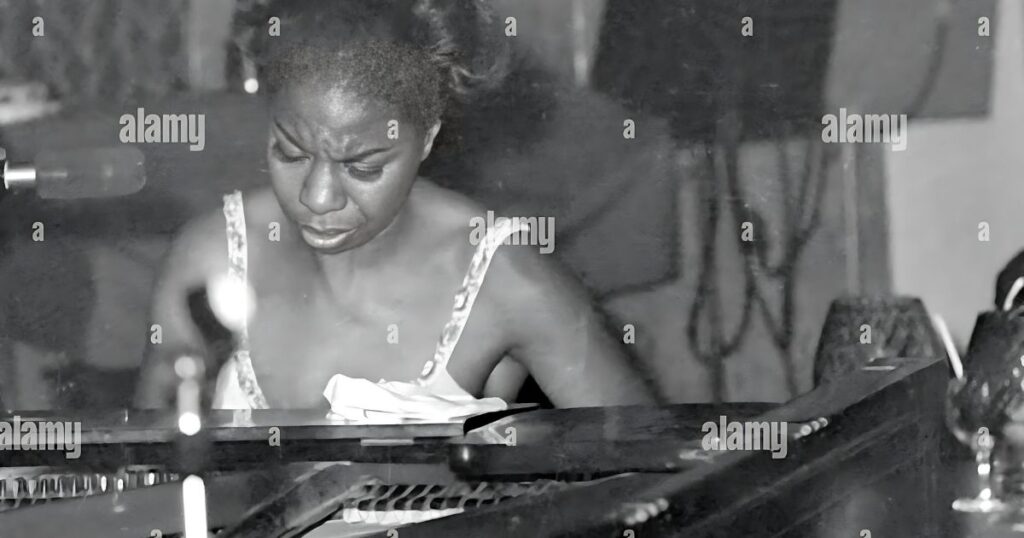
Later, around age eleven, Simone moved on to work with Vladimir Sokoloff, a professor at the Juilliard School. She commuted to New York for lessons with dreams of becoming America’s first black classical pianist. This intense training in her formative years gave Simone the strong classical foundation that she would later fuse into her boundary-breaking music.
Early Performances and Career Beginnings
By the time she was in her late teens, Nina Simone was giving piano recitals and performances around Tryon to help support her family. In 1950, she moved to Philadelphia to formally study piano and continue honing her craft. To pay for these studies, she taught piano lessons and played at bars in Atlantic City. Club owners insisted she sing too, prompting the shy pianist to add vocals to her act.
Simone’s 1954 debut performance at the Midtown Bar & Grill marked the beginning of her new career as Nina “Simone” – a stage name she adopted in honor of French actress Simone Signoret. Around this time, she befriended fellow artist Lorraine Hansberry, who nurtured her talents and encouraged her to incorporate political consciousness into her music.
Soon after, Simone was heard at the Midtown by Bethlehem Records, who quickly signed her. After releasing “I Loves You, Porgy” from Porgy and Bess, Simone shot to fame in 1959 with her debut album Little Girl Blue, followed by records like Nina Simone at Town Hall and Nina at the Village Gate.
Her soulful vocals and commanding piano skills earned her the moniker “High Priestess of Soul.” She was also known as a consummate live performer, giving energetic, charismatic shows. By the early 1960s, Simone had arrived as a major star on the national stage.
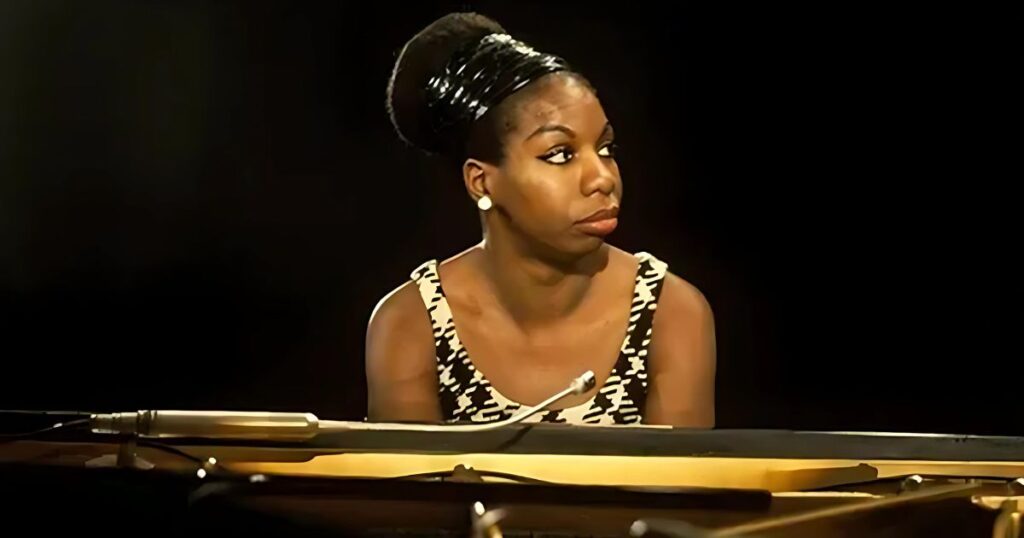
A Voice for the Civil Rights Movement
As the 1960s brought intensifying efforts for racial equality, Nina Simone became an outspoken activist and voice for justice. Many of her most iconic works reflect the passionate politics of this era.
In 1964, following the Birmingham Church Bombing that killed four girls, Simone penned the fiery protest song “Mississippi Goddam.” She boldly vented her anger while challenging the non-violent stance of leaders like Dr. Martin Luther King Jr. The provocative track was banned but solidified her role as a musical freedom fighter.
Other civil rights anthems written by Simone include “Four Women,” “Young, Gifted and Black,” and “To Be Young, Gifted and Black.” She performed at civil rights meetings, marches, and events across the nation, including the Selma to Montgomery marches. Her close friends included Langston Hughes, James Baldwin, and Lorraine Hansberry, who was the inspiration behind “To Be Young Gifted and Black.”
Outside of music, Simone was outspoken in interviews against racial injustice. Her advocacy likely prevented greater commercial success, but she stayed true to her principles and remained a prophetic voice throughout the 1960s.
Standing Up to Racism in Classical Music
Though Nina Simone drew much from her classical training, she also experienced discrimination in that world. After being rejected from the prestigious Curtis Institute in Philadelphia in the early 1950s, she became disillusioned with the racial barriers she faced.

Simone later recounted being told she would need to “sing spirituals or teach” due to her race, blocking her concert pianist aspirations. The institute denied her claims, but the classical establishment’s prejudices against black musicians were certainly real during this Jim Crow era.
Throughout her career, Simone highlighted such discrimination, once saying she “never was able to be part of the classical music world because of the color of my skin.” But she also subverted expectations by masterfully combining classical with other genres and putting her defiant stamp on the predominantly white art form.
While the racism she encountered kept Simone from the career she initially sought, it also fueled her fearless fight for justice in her music and beyond. She took the classical discipline she’d honed and forged her path to greatness.
Her Time Abroad in Self-Imposed Exile
By the early 1970s, amidst declining record sales and disputes with handlers over money, Nina Simone grew deeply disillusioned with the U.S. music industry and racism in American society. She spent much of the next few decades living abroad in self-imposed exile.
For a time, Simone lived in Barbados and Liberia, two African nations she hoped could offer an escape from the discrimination she experienced in her home country. She went on to reside primarily in Switzerland and the South of France from the early 90s until she died in 2003.
Simone’s years abroad were tumultuous but also inspired some of her most political work. The 1978 album Baltimore, recorded after she first left the States, tackled racism head-on in tracks like “Everything Must Change” and “Fodder on My Wings.” Her move overseas aligned with an increasingly global perspective in her music.
Living as an expatriate colored Simone’s feelings toward America. While she still spoke out against injustice, she often expressed weariness and disappointment. She saw promise in the younger generation’s activism during visits home. But the abroad years took an emotional and career toll as she felt detached from the civil rights fight.
Was She Bipolar? Mental Health Speculation
Rumors and speculation have long swirled regarding whether Nina Simone suffered from mental illness, particularly bipolar disorder. Loose talk has been used to explain away her volatility. But the truth resists easy diagnosis.
At times in her life, Simone did face mental health challenges. There are accounts of extreme highs and lows. She acknowledges taking lithium for a period. Daughter Lisa Celeste said she displayed symptoms resembling bipolar disorder.
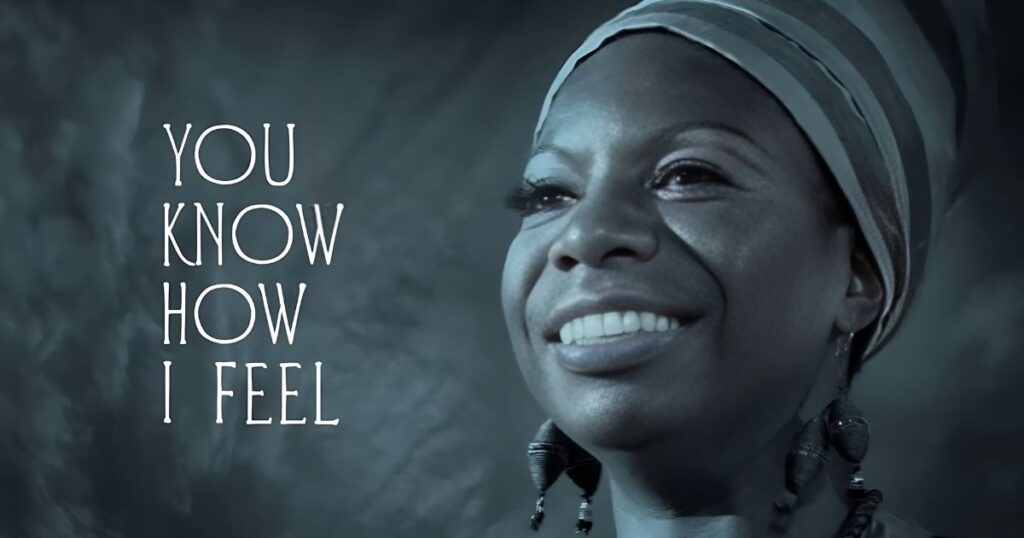
However, reducing Simone’s passionate, troubled existence to just a medical condition ignores the outside forces shaping her. The racism and turmoil she encountered profoundly impacted her state of mind. Being born with artistic brilliance in an oppressive world also took an emotional toll.
Moreover, labels like bipolar weren’t easily applied to Black women in Simone’s heyday. She was seen as an “angry woman,” not unlike how Billie Holiday was dismissed as a “junkie.” We must consider racial and gender biases in any analysis.
While mental illness may have played some role, the trauma of her experience and her incredible spirit were key. The complexity of Simone’s inner world transcends diagnoses. She deserves nuance and understanding, not just labels.
Nina Simone’s Last Photo
Some of the last known photos of Simone were taken in 2002, a year before she died. They show her enjoying time with her grandson in the south of France.
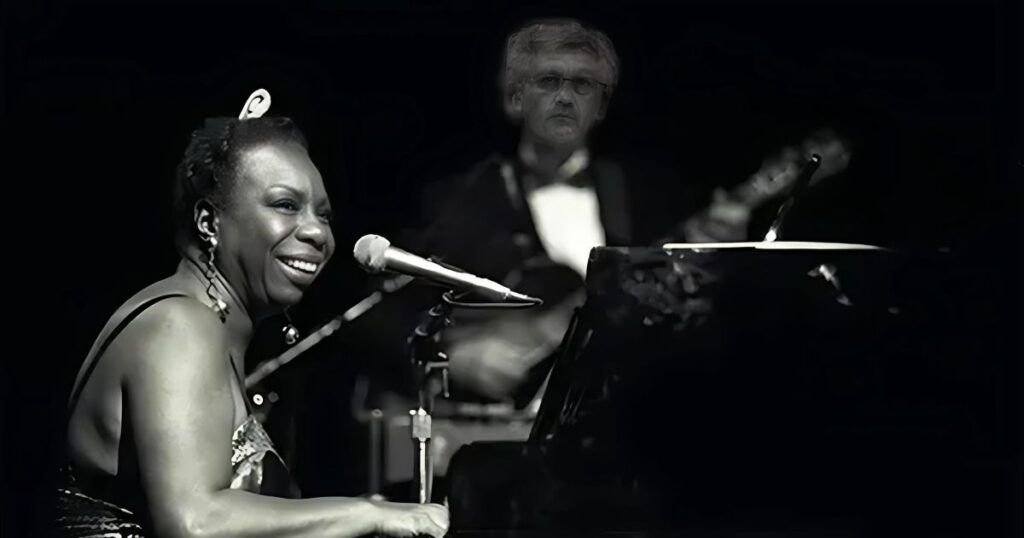
Nina Simone’s Childhood
Born in 1933 in North Carolina, Simone displayed great musical talent from a very young age. She first started playing piano at her church where her mother preached. Her childhood was marked by both gospel music and classical piano training.
Where Did Nina Simone Live?
Throughout her life, Simone lived in various cities across the U.S. like New York, Los Angeles, and Philadelphia. In the 1990s, she moved to France where she lived until she died in 2003.
Why Is Nina Simone Important?
Simone was important for blending musical genres, delivering bold socio-political lyrics, and aligning herself with the civil rights movement. She paved the way for future artists and left a lasting cultural legacy.
Interesting Facts About Nina Simone
- She was classically trained and aspired to be a concert pianist before becoming a singer
- She incorporated multiple musical styles like jazz, blues, folk, gospel, and pop into her works
- “Mississippi Goddam” was written in response to the Birmingham church bombing in 1963
- She was good friends with Lorraine Hansberry and James Baldwin
- She lived in Liberia and Barbados for a period in the 1970s
Nina Simone’s Daughter
- Simone’s only child, Lisa Celeste Stroud, was born in 1962. Like her mother, Lisa became a talented singer and took on the stage name Simone.
Her Daughter Lisa Celeste Carries Her Legacy
Nina Simone had one daughter – Lisa Celeste Stroud, born in 1962. Young Lisa was doted on by her mother yet also exposed to the turbulence of Simone’s life in entertainment. Lisa herself became an actress and singer who took on the stage name Simone in honor of her iconic mother.
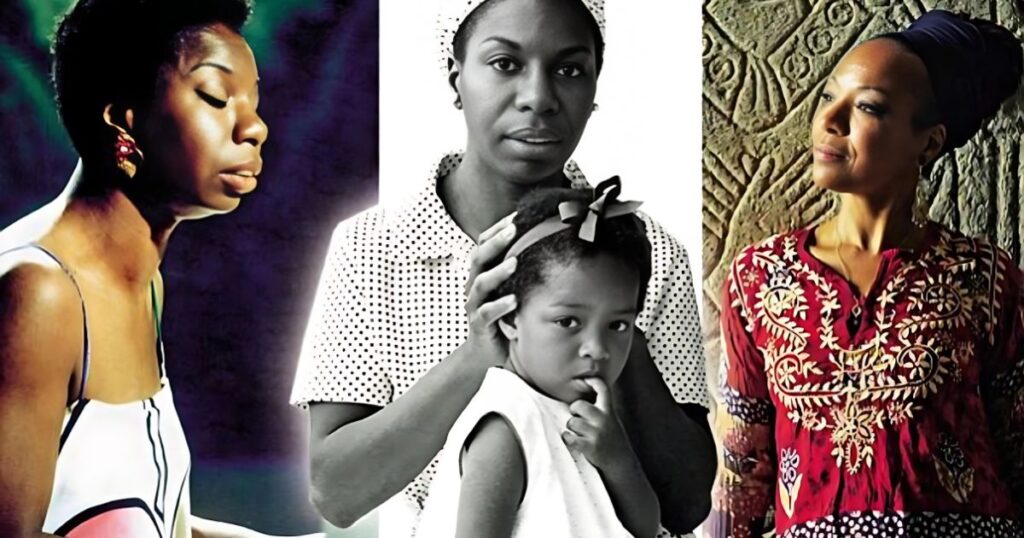
Lisa Celeste has shared both fond and difficult memories of growing up with Nina Simone as a mother. She recounted enduring endless rehearsals, moving constantly, and fearing her mother’s volatile moods. But she also remembers Simone teaching her about art and music. She sometimes even performed on stage with her mother as a child.
As an adult, Lisa Celeste appeared in films, on Broadway, and sang backup vocals for Lenny Kravitz. After Simone’s death, she worked to preserve her mother’s legacy. Lisa Celeste participated in the creation of multiple documentaries on Simone and oversees her estate.
On her mother’s birthday in 2021, Lisa Celeste announced an upcoming project – the Nina Simone Hologram Tour, allowing a virtual Nina to perform again. Though complex, Lisa Celeste’s relationship with her iconic mother fueled her creative path.
How Did Nina Simone Die?
In 2003, Simone passed away at the age of 70 in her sleep at her home in France. Her cause of death was reported to be breast cancer.
Light Continues to Shine at the Nina Simone House
In Tryon, North Carolina stands a humble three-room home where a young Nina Simone first discovered her musical gifts. This house on East Livingston Street was named to the National Register of Historic Places in 2011. It serves as a testament to Simone’s enduring connection to her hometown.
The house has been preserved as both a historic landmark and a community center called The Nina Simone Project. Music lessons are provided in her memory, especially for underprivileged children. Civil rights education is offered. The space hosts musical performances, plays, poetry readings, and more.
Visitors can tour Simone’s childhood home containing period furnishings and exhibits. The walls adorned with her portraits further bring her to life. Nina Simone’s Birthday, On her birthday each year, the cake is served and music is played
FAQs:
1: What caused Nina Simone’s death?
Nina Simone passed away in her sleep at her home in France in 2003 at the age of 70. The cause of her death was reported to be breast cancer that had spread throughout her body. She had been battling the disease for several years leading up to her death.
2: How old was Nina Simone when she died?
Nina Simone was 70 years old when she died in 2003. She was born in 1933 and had a long, prolific career that spanned over four decades before her death from cancer.
3: When did Nina Simone die?
Nina Simone died on April 21, 2003 at her home in Carry-le-Rouet, France. She passed away in her sleep after battling breast cancer. The world mourned the loss of the legendary singer and activist, who lived an incredible 70 years.
4: Who is Nina Simone’s daughter?
Nina Simone’s only child is her daughter Lisa Celeste Stroud. She was born in 1962 and used the stage name Simone in her own entertainment career. Lisa Celeste went on to become an actress, singer, and Broadway performer. She has carried on her mother’s legacy after Nina’s passing.
5: What was Nina Simone’s biggest hit?
Nina Simone’s rendition of “My Baby Just Cares For Me” became her biggest hit after it was featured in a commercial in the 1980s. The song was then re-released and peaked at number 5 on the UK singles chart. Other signature Nina Simone hits include “Feeling Good,” “Sinnerman,” and “I Put a Spell On You.”
6: Who did Nina Simone leave her money to?
After her death, Nina Simone left all of her estate and music rights to her only daughter, Lisa Celeste Stroud. This included the royalties from Simone’s vast catalog of albums and songs. Lisa Celeste continues to oversee her mother’s legacy and estate.
7: Why did Nina Simone have an accent?
Early in Nina Simone’s career, she purposefully adopted a mid-Atlantic accent after being told it would help her perform “classical” songs. This accent contributed to her refined, cultured persona and singing style. She eventually let the accent fade later in life.
8: Was Nina Simone a hero?
Yes, Nina Simone was a heroic figure both for her groundbreaking music and her fearless advocacy during the civil rights movement. She used her platform to promote racial justice and wrote songs that became protest anthems of empowerment.
9: When was Nina Simone’s last concert?
Nina Simone’s very last live performance was in 2002 at the Olympia Hall in Paris, France. She was 69 years old at the time and nearing the end of her life after battling cancer. The concert displayed her enduring talent as a pianist and vocalist.
10: Did Nina Simone have perfect pitch?
Yes, Nina Simone was gifted with perfect pitch. This allowed her to seamlessly transpose songs into new keys and lent an impressive precision to her vocals. Her innate musical abilities were evident from a very young age.
11: Did Nina Simone like singing?
Though classically trained as a pianist, Nina Simone grew to love singing later in her career. While she initially focused solely on piano, she embraced her versatile voice and scaled the charts with popular jazz, blues and folk vocal performances.
12: How would you describe Nina Simone’s voice?
Nina Simone’s voice was renowned for its deep, rich, emotive contralto tone. She had remarkable range and versatility that allowed her to fluidly cross musical genres. Her vocal delivery conveyed raw power and intimacy, pain and pride. Overall, her voice was simply unforgettable.
13: Did Nina Simone write her own songs?
Yes, Nina Simone is credited as the sole songwriter on many of her most iconic works. This includes hit songs like “Mississippi Goddam,” “Four Women,” “Young, Gifted and Black,” “To Be Young, Gifted and Black,” among others. She was a brilliant and prolific songwriter.
14: Did Nina Simone marry?
Nina Simone married twice in her lifetime. Her first marriage was to Don Ross, a beatnik musician, from 1958 to 1960. Her second was to detective Andrew Stroud from 1961 to 1970. The latter was a turbulent relationship that produced her only child, Lisa Celeste.
15: Who taught Nina Simone to play piano?
Nina Simone, born Eunice Waymon, first learned piano at a young age from her church’s pianist. She then studied under several private teachers like Muriel Mazzanovich and Vladimir Sokoloff before applying to the prestigious Curtis Institute of Music at age 17, though she was denied admission.
16: How much money did Nina Simone make?
At the peak of her career in the 1960s, it is estimated that Nina Simone earned around $1 to 3 million annually from record sales, concerts, and appearances. Her income declined in later decades but she still made a respectable living touring internationally up until the end of her life.
17: What are 2 facts about Nina Simone?
- She was trained in classical piano from a young age and incorporated Bach, Chopin, and other classical styles into her music.
- She was close friends with prominent Black figures like Langston Hughes, James Baldwin, and Lorraine Hansberry who influenced her socially conscious views.
18: Who influenced Nina Simone?
Nina Simone drew influence from diverse sources – classical composers like Bach, Debussy, and Chopin that she studied intensely, gospel and blues singers like Marian Anderson and Billie Holiday, jazz greats like Duke Ellington and Oscar Peterson, and pop artists like the Beatles later in her career.
19: Who owns Nina Simone’s music?
Nina Simone’s daughter Lisa Celeste Stroud currently owns the rights to her mother’s extensive song catalog and recording masters. After Simone’s death in 2003, her estate and assets were passed on to her only heir, Lisa Celeste, who protects her legacy as a musician and activist.

